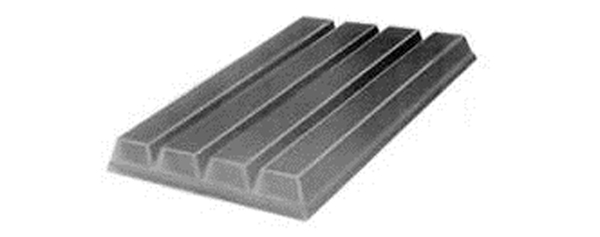No need to prove acquired distinctiveness of a mark in every Member State but extrapolation of quantitatively sufficient data obtained in other Member States to cover Member States without quantitatively sufficient data needs proper basis, says the Advocate General in the case concerning Kit Kat 4 fingers shape EU Trade Mark application.
Summary
The long running case concerning the validity of an EU trade mark (EU TM) covering the shape of Nestlé’s Kit Kat 4 fingers chocolate bar has now made it to the CJEU. On 19 April, Advocate General (AG) Wathelet rendered his opinion on the extent of evidence required to show acquired distinctiveness of a mark throughout the EU. As readers may remember, Nestlé had registered a trade mark for the 4 fingers shape but Cadbury Schweppes (now Mondelez) applied to cancel it. When the case was before the European Union Intellectual Property Office (EU IPO), Nestlé adduced survey evidence from 10 out of the 15 Member States forming the EU as at the filing date of 2002 to show that the mark had acquired distinctiveness throughout the EU. The EU IPO rejected Cadbury Schweppes’ application on this basis. However, on appeal, the General Court annulled the EU IPO’s decision because it said the EU IPO had not found acquired distinctiveness in all the Member States. Nestlé appealed to the CJEU.
In his opinion, the AG has reiterated the CJEU case law, that it would be unreasonable to require proof of acquisition of distinctive character through use for each Member State. However, the AG stated that the law required “quantitatively and geographically sufficient evidence” of acquisition of distinctive character through use of the mark throughout the EU, being as it was, a unitary right. Thus, according to the AG, for those Member States lacking in “quantitatively sufficient” evidence, acquired distinctiveness could be shown by extrapolating data obtained in other Member States, but such extrapolation had to have a proper basis for it, such as market comparability. By way of example, the AG said that the evidence of distinctiveness in Ireland could be equivalent to that in the UK because of geographical proximity, the existence of historical links, common language, customs or practices.
The decision of the CJEU is now awaited.
Law
Unlike words and logos, consumers do not usually identify the shape of a product as a trade mark, that is to say, a badge of origin. Thus, shape marks are usually not registrable for being “devoid of any distinctive character” - one of the absolute grounds of refusal as per Article 7(1)(b) of the EU Trade Mark Regulation (No207/2009). However, such marks can nevertheless be registered if it has “become distinctive in relation to the goods for which registration is requested in consequence of the use which has been made of it “(often referred to as “acquired distinctiveness”), per Article 7(3).
Background facts
In 2002, at the time when there were only 15 Member States in the EU, Nestlé applied to the EU IPO to register the following three-dimensional sign as an EU TM, which corresponds to the ‘Kit Kat 4 fingers’ shape which it markets:

The mark was successfully registered, but along came Cadbury Schweppes (now Mondelez UK Holdings & Services) which applied to invalidate the mark. One of the grounds for this was that the shape mark was not inherently distinctive and had not acquired distinctiveness throughout the EU.
To defeat Cadbury Schweppes' application, Nestlé adduced survey evidence in 10 out of the 15 Member States. There were other kinds of evidence including those for other Member States, such as Nestlé's advertising material.
Findings of the EU IPO (Second Board of Appeal)
The EU IPO rejected Cadbury Schweppes' invalidation request given that Nestlé had shown acquired distinctiveness in a substantial part of the EU (10 out of the 15 Member States, amounting to about 90 per cent of the EU population as at the date of the EU TM application). The survey showed that about half the respondents gave answers which probably meant that they thought the shape shown was a product known as KIT KAT. The EU IPO did not explicitly decide whether acquired distinctive character had been established in the remaining five Member States.
On appeal to the General Court
Cadbury Schweppes appealed to the General Court. The General Court found that the decision of EU IPO should be annulled. The EU IPO had erred by deciding that it was sufficient to show that the mark had acquired distinctiveness in a significant proportion of the relevant public throughout the EU, merging all the Member States. Nestlé had to show acquired distinctiveness throughout the territory of the EU, that is, “in all Member States concerned”.
Nestlé interpreted this to mean that it was required to show that the mark had acquired distinctive character through use in each of the Member States separately. This point was appealed to the CJEU.
Advocate General (AG) Wathelet's Opinion
The AG gave an opinion to advise the CJEU as to how the appeal should be resolved.
The AG opined that, as EU TMs have unitary character, the applicant must provide "quantitatively and geographically sufficient" evidence that the requisite distinctiveness was acquired in all the relevant EU Member States. However, CJEU case-law (Chocoladefabriken Lindt & Sprüngli v OHIM (C 98/11 P, EU:C:2012:307)) had acknowledged that it would be "unreasonable to require proof of acquired distinctiveness for each individual Member State". Thus, according to the AG, "quantitatively sufficient" evidence obtained in respect of other Member States may be extrapolated to apply to those Member States lacking in such data, but that requires a proper basis for it.
The AG considered that it would be common for economic operators like Nestlé to group together national markets based on "market comparability", dependent on shared characteristics such as geographical proximity, the existence of historical links, common language, customs or practices. Such comparability could form the basis of extrapolating quantitatively sufficient data to cover other markets without such data. Thus, said the AG, quantitatively sufficient evidence obtained in Spain might justifiably cover Portugal, and those for the UK might cover Ireland. In the present case there was no evidence of market comparability, leaving the General Court with no option but to annul the EU IPO's decision rejecting Cadbury Schweppes' claim.
We now await the CJEU’s final decision.
Cadbury Schweppes' Appeal
Cadbury Schweppes appealed the General Court’s finding that the mark had acquired distinctive character in the 10 Member States in which Nestlé had obtained survey evidence. The appeal was not admissible because Cadbury Schweppes had been overall successful before the General Court which had found that the EU IPO decision should be annulled.
Comments
Relationship with the UK proceedings
In 2010, Nestlé applied for a national mark in the UK. This was opposed by Cadbury Schweppes on grounds which included lack of distinctive character, maintaining that neither had the mark acquired distinctive character in the UK. The UK IPO agreed, and the decision was upheld on appeal by the High Court, and subsequently the Court of Appeal. Naturally, Nestlé drew the Court’s attention to the EU IPO’s decision which had found that Nestlé had established acquired distinctiveness in the 10 Member States (which included the UK) for which there was survey evidence. This finding was not touched by the General Court.
In its decision of May 2017, the Court of Appeal stated that it had taken “careful note” of the decision, but as it was not a ruling on a point of law, it did not have binding effect. The Court of Appeal justified departing from the finding of Board of Appeal/General Court because: (i) account was taken of some surveys which the hearing officer had found to be so seriously flawed as to render it wholly unreliable and; (ii) passages in the General Court decision suggested that it regarded recognition and association of the mark with Kit Kat as being sufficient to establish distinctiveness, contrary to CJEU case law which stipulated that the mark had to be perceived as designating a particular undertaking.
Implications for future shape mark cases
Whilst acknowledging that the CJEU had decided that it would be “unreasonable” to expect applicants (or proprietors) to provide proof of acquired distinctiveness for each individual Member State, the AG advised that the applicant needs to show that there is some basis for saying that the requisite distinctiveness is established in respect of the Member States where no “quantitatively sufficient” data exists. The AG’s guidance on how data can be extrapolated to cover other Member States is helpful, but the adequacy of evidence to show market comparability is likely to cause future debate. Applicants may view that it would be safer to simply conduct a survey (perhaps to a limited extent) for the Member States less relevant to their markets. Even so, such exercise is substantial, particularly since the membership of the EU has expanded considerably to now 28 Member States. Future applicants may opt to file national applications instead of an EU TM or in parallel. Alternatively, applicants may give greater consideration to filing for a registered Community design right – however such applications need to be made within 12 months of publication of the design in question.


